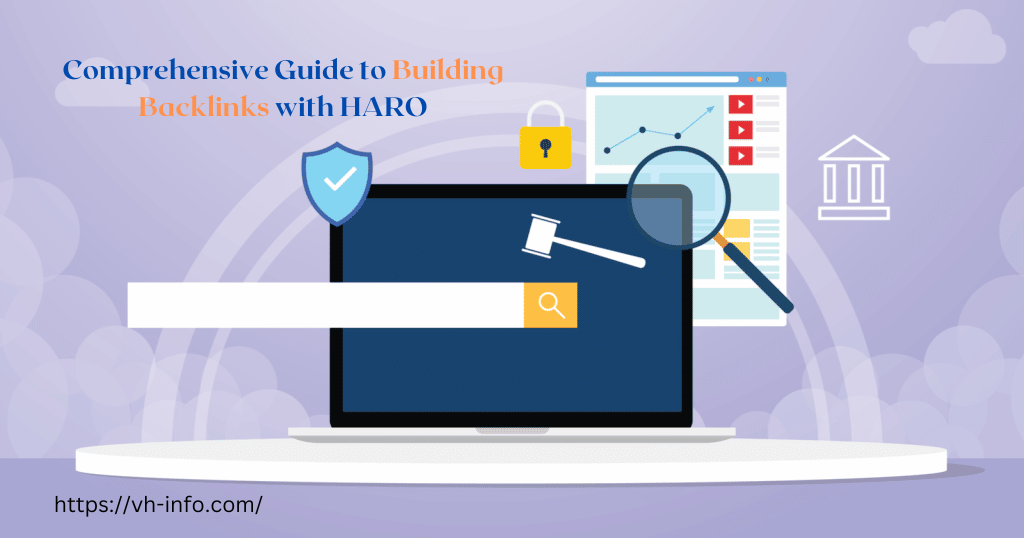Introduction: What is HARO Link Building and Why is it Important for SEO?
HARO Link Building is an effective strategy that involves obtaining backlinks from reputable websites using the HARO platform. Help A Reporter Out, or HARO is a platform that links reporters with sources for their stories.
Businesses can get a link back to their website in the ensuing article by providing journalists with answers to their questions that are related to their expertise or insights.
Due to the fact that it can considerably raise a website’s search engine ranks, HARO Link Building is crucial for SEO. Search engines receive signals from respectable backlinks that a website is reliable and authoritative, which can increase its exposure in search results.
A larger audience can be reached and firms can become recognized as thought leaders in their fields by using HARO Link Building.
Overall, HARO Link Building is a cost-effective and efficient way for businesses to earn high-quality backlinks and improve their SEO performance.
By incorporating HARO into their link-building strategy, businesses can stay ahead of the competition and establish a strong online presence.
How to Sign Up for HARO and Navigate the Platform
Signing up for HARO is a simple process that can be completed in a matter of minutes. To get started, visit the HARO website and click on the “Sign Up” button in the top right-hand corner.
Fill out the registration form with your name, email address, and other required information. Once you have completed the form, click on the “Register” button to create your account.
After you have signed up for HARO, the next step is to navigate the platform and find relevant link building opportunities.
To do this, log in to your account and browse through the various categories of queries. You can also use the search bar to find specific keywords or topics that are relevant to your business.
When you find a query that matches your expertise or industry, click on the “Pitch” button to submit your response. Make sure to read the query carefully and tailor your pitch to the journalist’s specific needs.
By following these steps, you can sign up for HARO and start building high-quality backlinks to your website.Bonus Read: Instagram Marketing Guide: 10 Tips That Actually Work
Tips for Writing Winning HARO Pitches
Crafting a winning HARO pitch is essential for securing backlinks and building relationships with journalists. Here are some tips for writing pitches that stand out from the competition:
- Be concise: Keep your pitch short and to the point. Journalists are busy and don’t have time to read lengthy emails.
- Offer value: Provide valuable insights or expertise that the journalist can use in their story. Make sure to explain why you are uniquely qualified to comment on the topic.
- Be relevant: Make sure your pitch aligns with the journalist’s query and is relevant to their audience.
- Customize your pitch: Avoid using generic templates or boilerplate language. Tailor your pitch to the specific journalist and their needs.
- Show your personality: Use a friendly, conversational tone and inject some personality into your pitch. This can help you stand out from other pitches and establish a personal connection with the journalist.
- Be professional: Double-check your grammar and spelling, and make sure your pitch is polished and professional.
By following these tips, you can increase your chances of success in HARO link building and establish yourself as a reliable source for journalists.
Finding Relevant HARO Opportunities
Finding relevant HARO opportunities is essential for successful link building. Here are some strategies for identifying and responding to HARO queries that align with your industry and expertise:
- Set up alerts: Set up keyword alerts for relevant topics or industries. This will ensure you receive notifications whenever a relevant query is posted.
- Check the deadlines: Make sure to check the deadlines for each query to ensure you have enough time to craft a strong pitch.
- Look for specific requests: Pay attention to specific requests in the query, such as quotes or case studies. If you have relevant data or experience, highlight it in your pitch.
- Analyze the outlet: Take a look at the outlet requesting the query. If it’s a reputable and relevant outlet, it’s worth investing time in crafting a pitch.
- Use filters: Use filters to narrow down the queries based on relevance, media type, and publication outlet. This will help you find the queries that are most relevant to your expertise.
By following these strategies, you can identify and respond to the most relevant HARO queries and increase your chances of securing high-quality backlinks for your website.
Best Practices for Building Relationships with Journalists
Building relationships with journalists is an important aspect of HARO link building. Here are some best practices for establishing and nurturing relationships with journalists:
- Be professional and courteous: Treat journalists with respect and professionalism, and respond to their queries promptly.
- Provide value: Offer valuable insights and expertise that are relevant to the journalist’s needs and audience.
- Follow up: Follow up with journalists after your initial pitch to see if they need any further information or assistance.
- Share their content: Share the journalist’s content on social media and tag them to show your support and appreciation.
- Be authentic: Be authentic and genuine in your interactions with journalists. Avoid overly promotional language and focus on building a personal connection.
- Be reliable: Deliver on your promises and provide high-quality content or quotes when requested. This will help establish you as a reliable source for future queries.
By following these best practices, you can establish strong relationships with journalists and increase your chances of securing high-quality backlinks through HARO link building.Bonus Read: The 10 best copy al alternative Tools in 2023
Measuring the Success of Your HARO Link Building Campaign
Measuring the success of your HARO link building campaign is crucial for evaluating its effectiveness and making necessary adjustments. Here are some metrics you can use to track the success of your HARO campaign:
- Backlinks: Monitor the number and quality of backlinks you have earned through HARO. High-quality backlinks from reputable publications can improve your website’s search engine ranking and drive traffic to your site.
- Traffic: Use website analytics tools to track the traffic driven to your site from the backlinks earned through HARO. This will help you evaluate the effectiveness of your link building efforts in driving traffic.
- Brand mentions: Keep track of any brand mentions or media coverage you receive through HARO. These can improve brand awareness and credibility.
- Relationships: Monitor the relationships you have built with journalists through HARO. Strong relationships can lead to future opportunities and collaborations.
By tracking these metrics, you can evaluate the success of your HARO link building campaign and make necessary adjustments to optimize your results.
Common Mistakes to Avoid in HARO Link Building
While HARO link building can be a valuable tactic for building backlinks and relationships with journalists, there are some common mistakes to avoid. Here are a few:
- Pitching irrelevant topics: Make sure your pitch is relevant to the journalist’s query and audience. Avoid pitching topics that are not a good fit.
- Failing to follow instructions: Carefully read and follow the journalist’s instructions for responding to their query. Failure to do so can result in your pitch being disregarded.
- Being too promotional: Avoid using overly promotional language in your pitch. Focus on providing valuable insights and expertise instead.
- Ignoring deadlines: Make sure to submit your pitch before the deadline specified in the query. Failing to do so can result in missed opportunities.
- Neglecting to build relationships: HARO link building is about more than just securing backlinks. Building relationships with journalists can lead to future opportunities and collaborations.
By avoiding these common mistakes, you can increase your chances of success in HARO link building and establish yourself as a reliable source for journalists.
Advanced Strategies for HARO Link Building
Once you have a solid understanding of the basics of HARO link building, you may want to explore advanced strategies to further optimize your results. Here are a few advanced strategies to consider:
- Focus on high-authority publications: Aim to secure backlinks from high-authority publications in your industry. These can have a greater impact on your search engine ranking and brand credibility.
- Create custom content: Consider creating custom content, such as infographics or videos, to offer as part of your pitch. This can increase the likelihood of your pitch being selected and increase the value of the resulting backlink.
- Use HARO as a networking tool: Use HARO to connect with other industry professionals and build relationships. This can lead to future collaborations and opportunities.
- Use HARO for content inspiration: Use HARO queries as inspiration for your own content. This can help you identify trending topics and create content that is relevant and timely.
By implementing these advanced strategies, you can further optimize your HARO link building efforts and achieve even greater results.
Real-Life HARO Link Building Success Stories
There are many real-life success stories when it comes to HARO link building. Here are a few examples:
- Digital marketing agency, Ignite Digital, used HARO to secure a backlink from Forbes for a client. This backlink helped increase the client’s domain authority and search engine ranking, resulting in increased traffic and leads.
- Financial technology startup, Stash, used HARO to secure a backlink from The New York Times. This backlink helped improve their brand visibility and credibility, leading to increased user acquisition and investor interest.
- Social media management company, Buffer, used HARO to secure a backlink from Inc.com. This backlink helped improve their search engine ranking and drove traffic to their website, resulting in increased sign-ups and revenue.
These success stories demonstrate the power of HARO link building and its ability to drive tangible results for businesses.
By using HARO strategically and effectively, businesses can secure high-quality backlinks from reputable publications, improve their search engine ranking, and drive traffic to their website.
Conclusion: Why HARO Link Building is a Must-Try SEO Tactic
In conclusion, HARO link building is a must-try SEO tactic for businesses looking to improve their search engine ranking, drive traffic to their website, and establish themselves as experts in their industry.
By using HARO to secure high-quality backlinks from reputable publications, businesses can improve their domain authority, increase brand credibility, and drive traffic to their website.
Additionally, HARO link building can help businesses build relationships with journalists and other industry professionals, leading to future collaborations and opportunities.
However, it is important to approach HARO link building strategically and avoid common mistakes such as pitching irrelevant topics or being too promotional.
By following best practices for HARO link building, businesses can increase their chances of success and achieve tangible results.
Overall, HARO link building is a valuable tactic for businesses of all sizes and industries. By incorporating it into their SEO strategy, businesses can improve their online visibility and achieve their marketing goals.
Raj Panchotiya
Raj panchotiya is a Link builder at vh-info. He likes to talk about Link building. In his free time, he likes to watch videos on youtube on the latest link building trends!
You can always reach out to Raj on LinkedIn



